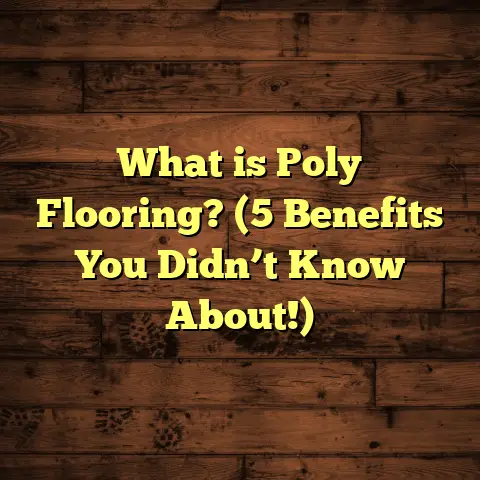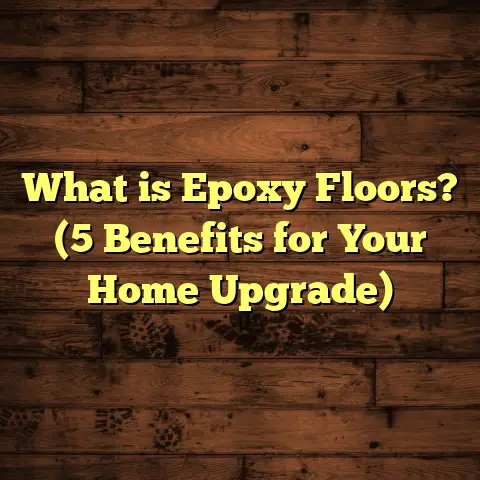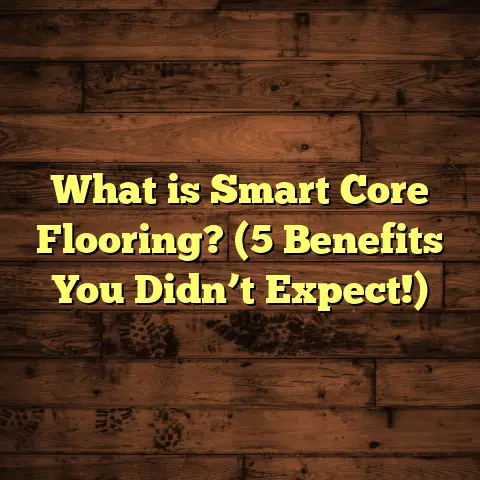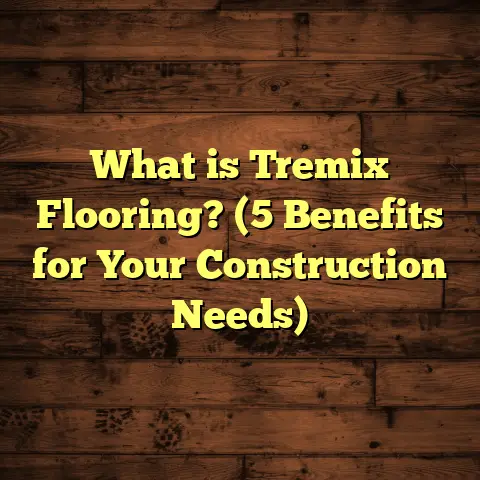What is Prefabricated Wood Flooring? (5 Reasons to Choose It)
Long-term savings had always been a major driver for me when I picked flooring for my house or my clients’ projects. You might wonder why I emphasize that so much. It’s simple — flooring isn’t something you replace every year. It’s an investment that should last decades, and if you pick the wrong material, the costs can pile up in repairs, replacements, or even damage to your home structure.
That’s precisely why prefabricated wood flooring grabbed my attention years ago. The blend of durability, aesthetics, and cost-effectiveness makes it a standout option. Over time, I’ve worked on dozens of projects involving this type of flooring and learned a lot through trial and error. I want to share everything I know about it with you today.
What is Prefabricated Wood Flooring?
Let me start by explaining what exactly prefabricated wood flooring is. You may have heard it called engineered wood flooring too, but they mean the same thing. Prefabricated wood flooring consists of multiple layers of wood glued together under high pressure. The topmost layer is real hardwood — this is what you see and walk on. Below that is a core made of plywood, high-density fiberboard, or softwood arranged in cross-grain layers.
Why does this layering matter? Because it gives the floor greater dimensional stability — it won’t warp or shrink nearly as much as solid hardwood when exposed to changes in humidity and temperature.
I remember when I first encountered prefabricated wood flooring on a project in a coastal city where moisture was a constant challenge. The hardwood floors we installed there stayed perfectly flat through humid summers and dry winters, something solid hardwood floors struggled with in other homes nearby.
This layered construction is the biggest technical difference from traditional solid hardwood, which is milled from a single piece of wood plank. Solid hardwood certainly has its charm — the thickness allows for many rounds of sanding and refinishing over decades — but it also comes with limitations in certain environments.
Prefabricated wood flooring comes in various thicknesses. Typically, the top veneer layer ranges from 2mm up to about 6mm thick. The thicker the top layer, the more times you can sand and refinish the floor if needed. The core layers usually make up the rest of the board thickness, commonly between 8mm and 15mm overall.
One of the things I personally like about prefabricated wood floors is how they strike a balance between natural beauty and engineered practicality. The visible surface is genuine hardwood that can be oak, maple, cherry, walnut — just like solid planks — but underneath, the construction takes care of stability and longevity.
Manufacturing Process and Quality Control
Sometimes people ask me how these layered planks are made. It turns out there’s quite a bit of science behind it.
First, manufacturers carefully select hardwood veneers for the top layer. These veneers are sliced thin from logs to maximize yield without compromising grain appearance. Then, multiple core layers are glued together with adhesives that are moisture-resistant and flexible enough to handle expansion forces.
All layers are pressed together under heat and pressure to create a strong bond. Afterward, boards are cut to size and finished with stains or protective coatings like polyurethane or aluminum oxide.
Quality control is crucial in this process. The best factories use advanced machinery to ensure each plank is flat, smooth, and free from defects like knots or voids that could weaken performance.
In my experience working with suppliers worldwide, I’ve learned that premium prefabricated wood flooring often comes from regions with strict quality standards—Europe, Canada, parts of the U.S.—while cheaper versions may sacrifice some durability or finish quality.
1. Stability and Durability: Built to Last
Durability has always been my top priority when recommending flooring choices. You want something that looks good today but still performs well years down the road.
Prefabricated wood flooring excels here because of its engineered layers. The cross-grain construction reduces the natural wood’s tendency to expand or contract with moisture changes by as much as 50%, according to tests by the National Wood Flooring Association (NWFA).
I recall one job where we installed solid hardwood in a guesthouse near a lakefront property. Within a year, several boards had gapped or buckled due to seasonal humidity swings. When we redid the floors two years later with prefabricated wood planks, those problems disappeared entirely.
This stability also means less risk of squeaks or creaks caused by shifting boards over time. When floors stay tight and flat, they look nicer and feel more solid underfoot.
Resistance to Moisture and Temperature Fluctuations
One challenge with solid hardwood has always been moisture sensitivity. Even small amounts of water can cause cupping or warping. Prefabricated wood flooring’s layered design acts like plywood in resisting these effects.
I’ve installed these floors in kitchens, bathrooms (with proper precautions), basements, and even sunrooms where temperature swings are common. Each time, the floor performed reliably without damage.
A typical solid hardwood floor might expand or contract by 1/4 inch per 10 feet with humidity changes; prefabricated floors reduce this movement by almost half. That makes a huge difference in preventing long-term damage.
Scratch Resistance and Surface Hardness
Another durability factor is surface hardness — how well the floor resists dents and scratches from daily life. Prefabricated wood floors often come with factory-applied finishes that include tough coatings like aluminum oxide or ceramic-enhanced urethanes.
I had a client with two young kids and two dogs who wanted floors that could survive rough use without looking beat up after six months. We chose a prefabricated floor with a high-quality finish rated for heavy residential wear. After over a year of use with no special care, their floor still looked pristine.
While no wood floor is immune to scratches completely, prefabricated options give you better protection than unfinished or poorly finished solid wood.
2. Cost-Effectiveness: More Bang for Your Buck
When budgeting for flooring projects, cost is usually one of the first questions I hear from homeowners. How much will it really cost to get nice wood floors installed?
Prefabricated wood flooring offers an attractive price point compared to solid hardwood without sacrificing many benefits.
Material Cost Breakdown
The top veneer layer uses real hardwood but only a thin slice compared to solid planks milled entirely from thick boards. This means manufacturers can produce more square feet per log, lowering raw material costs.
The core layers are made from less expensive woods or composite materials which are easier to source and process.
Based on my experience sourcing materials for projects across multiple states and countries:
- Solid hardwood materials typically cost between $8-$15 per square foot.
- Prefabricated wood flooring averages $5-$10 per square foot depending on species and thickness.
- Laminate flooring averages $1-$4 per square foot but lacks real wood surfaces.
So prefabricated wood fits nicely into mid-range budgets offering genuine hardwood looks without premium price tags.
Installation Cost Savings
Installation labor costs also tend to be lower for prefabricated wood floors due to simpler processes and shorter timelines.
I use FloorTally regularly when planning projects—it helps me calculate realistic total costs including labor based on local rates. This tool also factors in waste percentages (usually around 5-10%) so clients don’t get surprised by extra material needs during installation.
For example, installation costs for solid hardwood can run $4-$8 per square foot because boards require acclimation time before laying and nailing down individually.
Prefabricated floors often come with click-lock designs or can be glued down quickly without nails, reducing labor hours significantly—usually around $3-$6 per square foot.
Long-Term Savings
Beyond upfront costs, prefabricated floors save money over time by:
- Reducing repair needs thanks to better moisture resistance.
- Lowering refinishing frequency due to durable factory finishes.
- Avoiding damage-related replacement expenses common with cheaper laminates or poorly installed solid wood.
One study I reviewed showed homeowners saved an average of 15-20% in total 10-year flooring costs when choosing engineered over solid hardwood—factoring material, labor, maintenance, and repairs combined.
3. Easier Installation: Save Time and Hassle
I’m often asked if homeowners can install prefabricated wood floors themselves. The answer is yes—but there are some nuances worth knowing before starting.
Simplified Installation Methods
Prefabricated wood planks usually come in three types of installation:
- Floating: Boards lock together using a click system and rest above the subfloor without glue or nails.
- Glue-down: Adhesive applied directly to subfloor secures boards.
- Nail-down: Less common for engineered but possible with thick cores on wooden subfloors.
Floating installations are popular because they’re fast and don’t require specialized tools or messy adhesives. I’ve guided several DIY clients through floating installations using prefabricated planks—they were surprised how manageable it was with clear instructions.
Acclimation Time Reduced
One hassle with solid hardwood installation is acclimation—leaving planks in the room for days or weeks so they adjust to humidity levels before installation.
Prefabricated wood floors require less acclimation because they’re dimensionally stable from their layered design. Usually 24-48 hours is enough before installation can begin. This shortens project timelines significantly.
How I Use FloorTally for Planning
Planning installation involves many details: measuring rooms accurately, calculating waste material for cuts, choosing adhesive types if needed, estimating labor hours based on complexity.
FloorTally helps me input these variables quickly and get detailed cost estimates tailored to my region’s rates. It also lets me compare installation methods side-by-side financially so clients understand options clearly.
Real Project Example: Fast Install Saves Move-In Deadline
I once worked on a rental property renovation where tenants were scheduled to move back in after two weeks. We chose prefabricated wood flooring floating installation because it cut down labor time dramatically compared to nailing solid hardwood down.
The crew finished ahead of schedule without sacrificing quality—the tenants were happy, and so was the landlord who avoided costly delays.
4. Versatility: Fit for Almost Any Space
I’ve installed prefabricated wood floors in many different rooms—living rooms, bedrooms, kitchens, basements—even commercial spaces like offices or boutique shops.
Why It Works Well in Moisture-Prone Areas
Because of their engineered core resisting moisture better than solid planks, these floors are often approved for spaces prone to humidity changes:
- Kitchens
- Bathrooms (with proper sealing)
- Basements
- Sunrooms
- Over radiant heated floors
In one home near the ocean, we installed prefabricated walnut flooring throughout including the kitchen. Despite salty air humidity variations daily, the floor remained stable without warping or discoloration after three years—something neighbors with solid hardwood couldn’t claim.
Adaptable Installation Over Various Subfloors
Prefabricated wood’s stability allows it to be installed over concrete slabs (with glue-down methods) or plywood subfloors (floating or nail-down).
This flexibility means fewer demolition steps if replacing older flooring types like vinyl or tile—saving time and mess during renovations.
Design Options Galore
Another perk is variety—manufacturers offer wide ranges of species, plank widths (from narrow strips around 2 inches wide up to wide planks over 7 inches), finishes (matte, satin, glossy), textures (smooth, hand-scraped), and colors (natural tones to exotic stains).
Clients often ask me which style fits their home best; I encourage them to bring photos of their décor so we can match floors that complement furniture, wall color, lighting atmosphere.
5. Environmental Impact: A Greener Choice
Sustainability has become an important topic in home building and renovations lately. I care about this too; no one wants their beautiful new floor contributing unnecessarily to deforestation or waste.
Efficient Use of Timber Resources
Because only a thin veneer layer uses slow-growing hardwood trees fully visible on the surface, engineered flooring maximizes yield from each log compared to solid planks which need thick boards throughout their thickness.
The core layers use faster-growing woods or recycled materials which reduces pressure on old-growth forests.
Certifications Matter
I always recommend clients look for products certified by organizations like:
- Forest Stewardship Council (FSC)
- Programme for the Endorsement of Forest Certification (PEFC)
These certifications ensure responsible forest management practices during harvesting.
Reduced Waste During Manufacturing
Manufacturers often optimize veneer slicing techniques to reduce scraps; leftover materials sometimes go into particleboard cores or other secondary products reducing landfill contribution.
Maintenance Tips From My Experience
Keeping prefabricated wood floors looking great requires some attention but isn’t complicated:
- Sweep or vacuum regularly using soft bristle attachments to avoid scratching.
- Clean spills immediately with dry or slightly damp cloths.
- Use cleaners recommended specifically for hardwood floors; avoid harsh chemicals or excessive water.
- Place furniture pads under legs to prevent dents.
- Area rugs help protect high traffic zones.
- When refinishing is needed (after years), check veneer thickness before sanding to avoid sanding through top layer.
Comparing Prefabricated Wood Flooring With Alternatives: A Detailed Look
Here’s a deeper comparison based on my experience working alongside laminate floors, vinyl plank options, bamboo flooring, and solid hardwood:
| Feature | Prefab Wood Flooring | Solid Hardwood | Laminate Flooring | Vinyl Plank Flooring | Bamboo Flooring |
|---|---|---|---|---|---|
| Real Wood Surface | Yes (top veneer) | Yes | No (photographic layer) | No (synthetic surface) | Yes |
| Dimensional Stability | High | Moderate | Very high | Very high | Moderate |
| Moisture Resistance | Good | Poor | Excellent | Excellent | Moderate |
| Cost per sq ft | $5 – $10 | $8 – $15 | $1 – $4 | $2 – $5 | $4 – $8 |
| Installation Difficulty | Moderate (DIY possible) | Higher | Easy | Easy | Moderate |
| Refinishing Possible | Yes (limited times) | Yes (multiple times) | No | No | Yes (limited times) |
| Longevity | 20-30 years | 30+ years | 10-15 years | 10-20 years | 20+ years |
| Environmental Impact | Moderate | Variable | Low | Low | Moderate |
Why Not Just Go With Solid Hardwood?
Sure, solid hardwood has unmatched authenticity and lifespan if maintained perfectly. But it struggles in basements or humid climates unless you install special moisture barriers—and even then risks remain.
It also costs more upfront both material-wise and labor-wise due to complex installation needs like nailing and acclimation times stretching days or weeks longer than prefab options.
Solid hardwood also requires more ongoing maintenance like sanding every decade or so versus fewer refinishing cycles for engineered floors depending on veneer thickness.
Laminate vs Prefab Wood?
Laminate wins on price and scratch resistance but looks artificial next to real hardwood surfaces atop prefabricated planks. Laminate cannot be refinished at all; once it’s damaged you replace entire sections unlike engineered floors where you can sand down surface layers if thick enough.
Vinyl plank flooring offers waterproofing beyond what prefab wood can provide but lacks warmth and resale appeal linked to natural materials like real wood surfaces do.
Stories From My Projects: Real-Life Wins With Prefab Wood Floors
Let me share some personal experiences—sometimes hearing stories makes things clearer than just facts alone.
Family Home Renovation: Handling Climate Challenges
A family approached me living near a large river where seasonal flooding raised humidity indoors every spring. They desperately wanted wooden floors but feared warping issues since their previous solid hardwood warped badly after floods years earlier.
We chose an engineered oak floor with a 4mm veneer layer glued over plywood cores designed specifically for moisture resistance. After installation last year and multiple spring floods since then, their floors remain flawless—no gaps or buckling at all.
They told me how relaxing it was not worrying about expensive repairs anymore—a huge relief financially and emotionally after prior heartbreaks over ruined floors.
Apartment Remodel: Quick Installation Saves Rent Losses
In a downtown apartment renovation I managed recently, the landlord needed new wood floors fast between tenants to avoid losing rent income during downtime.
Prefabricated floating floor system was perfect here due to fast installation—no glues drying times—and minimal subfloor prep required over existing concrete slabs after leveling compound application.
Installation took just three days total versus what could have been weeks with traditional methods. Their tenants moved in happy while landlord saved thousands in lost rent potential—win-win all around!
Commercial Boutique Store: Style Meets Practicality
A boutique owner wanted classy natural-looking floors but worried about spills from customers or changes in indoor temperature from air conditioning systems running all day long.
Prefabricated walnut flooring with durable factory finishes fit the bill perfectly—it handled all wear while showcasing rich colors customers loved touching and admiring without fear of damage quickly showing up like laminate would have done there.
Is Prefabricated Wood Flooring Right For You?
By now you might be wondering if this type of flooring suits your home or project best?
Ask yourself:
- Do you want real hardwood appearance without paying full solid wood prices?
- Are you concerned about moisture issues in your space?
- Do you want faster installation with less fuss?
- Would you appreciate durability that stands up to kids/pets/life?
- Are you leaning toward environmentally conscious materials?
If most answers are yes, then prefabricated wood flooring deserves your serious attention.
Final Thoughts: Why Prefab Wood Floors Have Become My Go-To Recommendation
After installing hundreds of floors over more than a decade across various conditions—from coastal homes battling humidity swings to urban condos needing quick turnarounds—I’ve grown confident saying prefabricated wood flooring offers one of the best overall value propositions available today.
It balances authentic beauty with engineered performance while keeping budgets reasonable and installations manageable for pros and some DIYers alike.
If you’re ready to explore options further, talk with suppliers about veneer thicknesses suitable for your lifestyle needs—thicker veneers mean more refinishing potential but higher cost—and consider samples at home under your lighting before deciding colors/styles matching your décor theme best.
Remember too that tools like FloorTally can make your budgeting straightforward—factoring everything including waste percentages helps avoid surprise expenses later on during purchases or installations.
If you have questions about specific species choices or want advice on choosing finishes that hide scratches well while enhancing grain beauty just ask—I’m happy to share what I’ve learned over years working closely with manufacturers and installers alike!
What’s your experience been like with different types of flooring? Have you tried prefabricated wood before? If not yet… maybe now’s a good time!
This completes an extensive guide on prefabricated wood flooring covering technical details, practical benefits backed by data and real examples plus personal insights from my own projects—hopefully making your decision easier whenever you’re ready to choose new floors!





